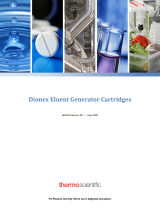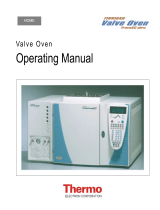Page is loading ...

TracePLOT GC columns
Use and care instructions
GC columns
Instruction sheet | DOC007
Installing the column
1. Before removing the previously installed column from the
gas chromatograph (GC), be sure to turn o the detector
and cool all heated temperature zones.
2. Once all zones of the GC are cooled, turn o all gases.
Remove the installed column, plug each end with silicone
septa (or column end caps), and return the column to its
original box.
3. Remove the new Thermo Scientific™ TracePLOT™ GC
Column from its box. Remove the septa (or column
end-caps) that are on each end of the TracePLOT column.
Important: If your column is tied onto the metal cage with
high-temperature string, do not remove the string. This high-
temperature string can withstand temperatures up to 400 °C.
4. Attach the appropriate GC capillary nut (fitting) onto the
inlet side of the column. Attach the appropriate GC column
ferrule onto the inlet side of the column.
Fused silica columns:
•0.25 mm columns, use 0.4 mm ID ferrule
•0.32 mm columns, use 0.5 mm ID ferrule
•0.53 mm columns, use 0.8 mm ID ferrule
Note: Do not install the capillary column nut (fitting) or
ferrule onto the outlet side of the column at this time;
this will be performed later.
Note: See ‘Tips and Tricks’ section for information on
using particle traps.
5. Trim 2 cm from both ends of the column. If the fused silica
column is flame sealed, remove 20 cm from both ends. Make
sure that a clean, square cut is obtained. Install the inlet side
of the column into the GC injection port at the appropriate
distance (see your GC manual to determine the correct
installation distance).
6. Turn on the carrier gas flow, using Table 1 to determine an
appropriate head pressure.
Note: A small amount of particles may exit the column when
the carrier gas is first turned on. This is normal as particles can
become dislodged when the column is cut, when a ferrule is
tightened onto a column, or due to vibrations during transport.
See ‘Protection from particles’ section.
7. Purge the column with clean, dry carrier gas for at least
20 minutes. During this purging step, check for leaks at the
injector connections using an electronic leak detector. Note
that the use of carrier gas filters is also highly recommended.
Important: If using hydrogen as the carrier gas, be sure to safely
vent the gas exiting the column and the split vent.

Table 1. Approximate head pressures (at 40 °C) using hydrogen and helium
Column
length
Internal
diameter Approximately psi Approximately kPa Approximately psi Approximately kPa
Head pressure for -Q, -Q+, -S,
and BOND-U
Head pressure for Sieve 5A
and all BOND Alumina
15 m 0.25 mm 6.5 45 10 69
15 m 0.32 mm 321 6.5 45
15 m 0.53 mm 1.5 10 214
30 m 0.25 mm 9.5 66 11. 5 79
30 m 0.32 mm 641 962
30 m 0.53 mm 2.5 17 3.5 24
50 m 0.25 mm 18 124 – –
50 m 0.32 mm 10 69 14 97
50 m 0.53 mm 3.5 24 641
8. Set the injection port temperature according to the method,
but do not exceed the maximum operating temperature for
the column. Set the GC oven to 40 °C.
9. Program the GC oven to heat up at 5 °C/min up to the
column’s maximum temperature.
10. Once the column’s maximum temperature is reached, hold
this temperature for at least 60 minutes for porous polymer
columns (-Q, -Q+, -S and BOND-U), and for at least 2 hours
for molecular sieve and alumina columns. Do not exceed
6 hours for any column.
11. Cool the GC oven. Do not turn o the carrier gas. Do not
remove the inlet side of the column from the injection port.
12. Attach the appropriate capillary column nut (fitting) to the
outlet side of the column. Attach the appropriate GC column
ferrule to the outlet side of column. Trim an additional 1 cm
from the outlet side of the column and verify that a clean,
square cut is obtained. Before installing the column into the
detector, pre-seat the ferrule onto the column. This will help
prevent dislodged particles from entering the detector.
13. Install the column into the detector at the appropriate distance
(see your GC manual to determine the correct installation
distance). Confirm that your detector gases and electronics
are turned on, then set the appropriate detector and injector
temperatures for your analysis and allow them to stabilize.
You are now ready to use the column.
Tips and tricks
Temperature limits
Never exceed the recommended maximum temperature of the
column, which is given on the box label for each TracePLOT
column.
Column regeneration
• Occasionally, Thermo Scientific™ TracePLOT™ TG-BOND
Alumina Columns need to be regenerated to remove moisture.
To regenerate, set the carrier gas head pressure as shown in
Table I, set the GC oven temperature to the maximum column
operating temperature, and condition the column for 6 hours.
• Occasionally, Thermo Scientific™ TracePLOT™ TG-BOND Sieve
5A Columns also need to be regenerated to remove moisture.
To regenerate, set the carrier gas head pressure as shown in
Table I, set the GC oven temperature to the maximum column
temperature, and condition the column for 1–3 hours.
Caution: If using hydrogen as a carrier gas, subjecting molecular
sieve columns to high temperatures using hydrogen carrier gas
for more than an hour will cause surface activity, resulting in
carbon monoxide (CO) peak tailing.
2

Protection from particles
• TracePLOT columns are not ideal for use in MS or valve
systems due to their potential to generate particles that
can contaminate and, in severe cases, damage GC parts.
If a TracePLOT column must be used in these instances,
a particle trap is necessary to reduce the chances of particles
getting into the GC system. Please see Table 2 for a list of
available particle traps.
• If the TracePLOT column will be connected to a mass
spectrometer (MS), the pressure drop (vacuum) may dislodge
particles into the MS. To minimize the amount of particles
from entering the MS, couple the detector end of the
TracePLOT column to a particle trap (e.g., 5 m × 0.25 mm ID
fused silica tubing coated with 0.25-0.50 μm of a nonpolar
stationary phase, such as TG-1MS phase). Use a connector
suitable for MS application.
• If the TracePLOT column will be connected to a non-MS
detector, connecting a particle trap to the detector end of
the column is recommended.
• To ensure protection against particles flushing back into a
valve/flow switching setup, connecting a particle trap to the
injector end of the TracePLOT column is recommended.
• If the TracePLOT column is connected using a valve/flow
switching setup, use of a particle trap on the outlet and inlet
ends is recommended to minimize the number of particles
entering the GC system. Conditioning the column as
instructed under steps 6-11 (previous page) using three times
higher gas flow to elute any loose particles is recommended.
After column conditioning is complete, restore normal column
flow and connect to the detector as described in steps
12-13. Now your column is stable for valve/flow switching
applications.
Table 2. Fused silica TracePLOT particle traps
Description Includes Quantity Cat. no
Thermo Scientific™ TracePLOT™
Particle Trap, 0.32 mm ID
Press-Tight connectors (2);
2.5 m, 0.32 mm ID column;
high-temperature string
Each 60180-860
Thermo Scientific™ TracePLOT™
Particle Trap, 0.53 mm ID
Press-Tight connectors (2);
2.5 m, 0.53 mm ID column;
high-temperature string
Each 60180-861
Protection from high boiling
To prevent high boiling point compounds from contaminating a
TracePLOT column, use of a precolumn (backflush column) or
a valve/flow switching system should be considered.
Variation in color and appearance
Please note that TracePLOT columns have a unique appearance
due to the particle deposition on the inside wall of the columns.
Variation in color and appearance is normal and does not aect
performance.
Protection from dislodged
Never abruptly pull the inlet end of the column from the injector
while under pressure; this can cause a pressure surge in the
column, resulting in particles being dislodged. Instead, turn
o pressure to the injector and allow it to drop to atmospheric
pressure before disconnecting the column.
3
Image 1. Fused silica TracePLOT particle traps

Ordering information
Thermo Scientific™ TracePLOT™ TG-BOND Alumina GC Columns
ID (mm) Length (m) Film thickness (μm) Quantity Cat. no.
Na2SO4 deactivation
0.32 30 5 1 each 26001-6020
50 5 1 each 26001-6050
0.53 30 10 1 each 26001-6080
50 10 1 each 260 01-6110
KCl deactivation
0.32 30 5 1 each 26002-6020
50 5 1 each 26002-6050
0.53 30 10 1 each 26002-6080
50 10 1 each 260 02-6110
Thermo Scientific™ TracePLOT™ TG-BOND Sieve 5A GC Columns
ID (mm) Length (m) Film thickness (μm) Quantity Cat. no.
0.32 15 30 1 each 26003-6010
30 30 1 each 26003-6040
0.53
15 50 1 each 26003-6070
30 50 1 each 26003-6100
50 50 1 each 26003-1630
Thermo Scientific™ TracePLOT™ TG-BOND Q GC Columns
ID (mm) Length (m) Film thickness (μm) Quantity Cat. no.
0.32 15 10 1 each 26004-6000
30 10 1 each 26004-6030
0.53 15 20 1 each 26004-6060
30 20 1 each 26004-6090
Thermo Scientific™ TracePLOT™ TG-BOND Q+ GC Columns
ID (mm) Length (m) Film thickness (μm) Quantity Cat. no.
0.32 15 10 1 each 26005-6000
30 10 1 each 26005-6030
0.53 15 20 1 each 26005-6060
30 20 1 each 26005-6090
4

For Research Use Only. Not for use in diagnostic procedures. © 2023 Thermo Fisher Scientific Inc. All rights reserved. All
trademarks are the property of Thermo Fisher Scientific and its subsidiaries unless otherwise specified. This information is presented
as an example of the capabilities of Thermo Fisher Scientific products. It is not intended to encourage use of these products in any
manner that might infringe the intellectual property rights of others. Specifications, terms and pricing are subject to change. Not all
products are available in all countries. Please consult your local sales representative for details. DOC007-EN 0623
Learn more at thermofisher.com/gccolumns
Thermo Scientific™ TracePLOT™ TG-BOND S GC Columns
ID (mm) Length (m) Film thickness (μm) Quantity Cat. no.
0.32 15 10 1 each 26006-6000
30 10 1 each 26006-6030
0.53 30 20 1 each 26006-6090
Thermo Scientific™ TracePLOT™ TG-BOND U GC Columns
ID (mm) Length (m) Film thickness (μm) Quantity Cat. no.
0.32 15 10 1 each 26007-6000
30 10 1 each 26007-6030
0.53 30 20 1 each 26007-6090
Ordering information (continued)
Thermo Scientific gas filters and leak detectors
Description Quantity Cat. no.
Carrier gas filter
Thermo Scientific™ Super Clean™ Gas Cartridge
Indicating triple filter (moisture, oxygen, hydrocarbons) 1 each 60180-824
Thermo Scientific™ Click-On™ Inline Gas Filter
Triple filter (moisture, oxygen, hydrocarbons) 1 each 60180-805
Electronic leak detector
Thermo Scientific™ GLD Pro Gas Leak Detector 1 each 66002-004
/












